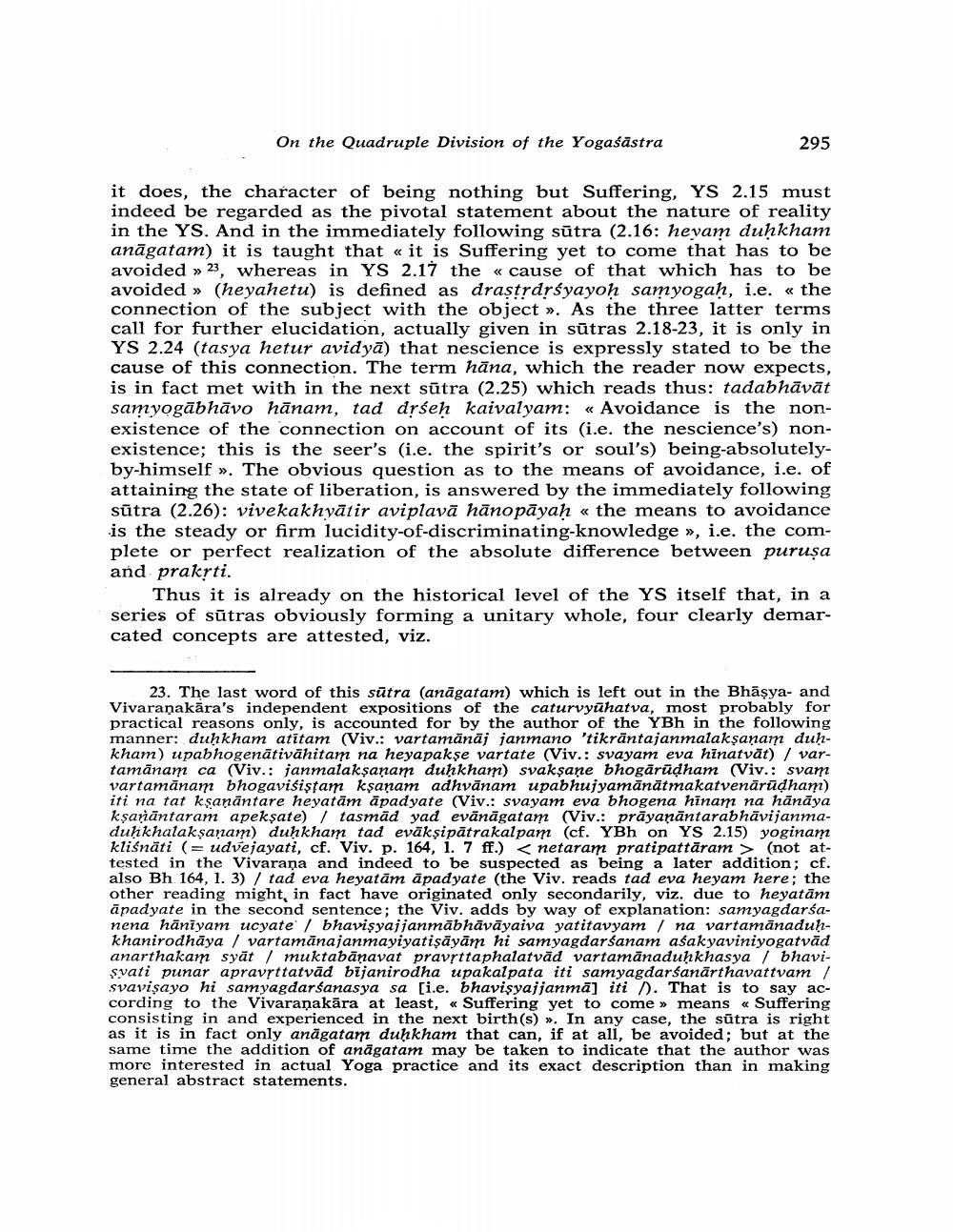Book Title: On Quadruple Division Of Yogasastra Author(s): A Wezler Publisher: A Wezler View full book textPage 7
________________ On the Quadruple Division of the Yogaśāstra 295 it does, the character of being nothing but Suffering, YS 2.15 must indeed be regarded as the pivotal statement about the nature of reality in the YS. And in the immediately following sūtra (2.16: heyam duḥkham anāgatam) it is taught that it is Suffering yet to come that has to be avoided >> 23, whereas in YS 2.17 the « cause of that which has to be avoided » (heyahetu) is defined as drastrdrśyayoḥ samyogah, i.e. « the connection of the subject with the object ». As the three latter terms call for further elucidation, actually given in sūtras 2.18-23, it is only in YS 2.24 (tasya hetur avidyā) that nescience is expressly stated to be the cause of this connection. The term hāna, which the reader now expects, is in fact met with in the next sūtra (2.25) which reads thus: tadabhāvāt samyogābhāvo hānam, tad drśeh kaivalyam: « Avoidance is the nonexistence of the connection on account of its (i.e. the nescience's) nonexistence; this is the seer's (i.e. the spirit's or soul's) being-absolutelyby-himself ». The obvious question as to the means of avoidance, i.e. of attaining the state of liberation, is answered by the immediately following sūtra (2.26): vivekakhyātir aviplavā hānopāyah « the means to avoidance is the steady or firm lucidity-of-discriminating-knowledge », i.e. the complete or perfect realization of the absolute difference between purusa and prakrti. Thus it is already on the historical level of the YS itself that, in a series of sūtras obviously forming a unitary whole, four clearly demarcated concepts are attested, viz. - 23. The last word of this sūtra (anāgatam) which is left out in the Bhāşya- and Vivaranakāra's independent expositions of the caturvyūhatva, most probably for practical reasons only, is accounted for by the author of the YBh in the following manner: dunkham atitam (Viv.: vartamānāj janmano 'tikrāntajanmalaksanam dunkham) upabhogenātivāhitam na heyapakse vartate (Viv.: svayam eva hinatvāt) / vartamānanca (Viv.: janmalaksanam dunkham) svakşane bhogārūdham (Viv.: svam vartamānam bhogavisiştam ksanam adhvānam upabhujyamānātmakatvenārūdham) iti na tat kşanāntare heyatām āpadyate (Viv.: svayam eva bhogena hinam na hānāya kşarāntaram apeksate) / tasmād yad evānāgatam (Viv.: prāyanāntarabhāvijanmaduḥkhalaksanam) dunkham tad evākṣipātrakalpam (cf. YBh on YS 2.15) yoginam kliśnāti (= udvejayati, cf. Viv. p. 164, 1. 7 ff.) < netaram pratipattāram > (not attested in the Vivarana and indeed to be suspected as being a later addition; cf. also Bh 164, 1. 3) / tad eva heyatām ápadyate (the Viv. reads tad eva heyam here; the other reading might, in fact have originated only secondarily, viz. due to heyatām āpadyate in the second sentence; the Viv. adds by way of explanation: samyagdarśanena hāniyam ucyate / bhavişyajjanmābhāvāyaiva yatitavyam/ na vartamānadunkhanirodhāya / vartamānajanmayiyatişāyām hi samyagdarśanam asakyaviniyogatvād anarthakam syāt / muktabānavat pravsttaphalatvād vartamānaduḥkhasya / bhavisvati punar apravrttatvād bijanirodha upakalpata iti samyagdarśanārthavattvam / svavişayo hi samyagdarśanasya sa [i.e. bhavisyajjanmā] iti /). That is to say according to the Vivaranakāra at least, « Suffering yet to come » means « Suffering consisting in and experienced in the next birth(s)». In any case, the sūtra is right as it is in fact only anāgatam duḥkham that can, if at all, be avoided; but at the same time the addition of anāgatam may be taken to indicate that the author was more interested in actual Yoga practice and its exact description than in making general abstract statements.Page Navigation
1 ... 5 6 7 8 9 10 11 12 13 14 15 16 17 18 19 20 21 22 23 24 25 26 27 28 29 30 31 32 33 34 35 36 37 38 39 40 41 42 43 44 45 46 47 48 49
